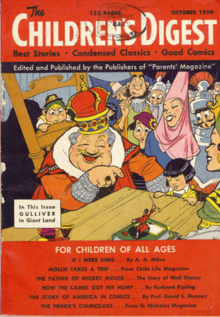Children's Digest
 The front cover of the October 1950 issue of Children's Digest, the first issue of this publication | |
| First issue | October 1950 |
|---|---|
| Final issue | May/June 2009 |
| Country | United States |
| ISSN | 0272-7145 |
Children's Digest (originally The Children's Digest) was a children's magazine published from Oct. 1950 to May/June 2009, after which it was merged with Jack and Jill from the same publisher. For over 20 years it was published in the digest size implied by its name, but it subsequently switched to a larger format more similar to other magazines. Humpty Dumpty Magazine is a sister publication of similar format aimed at a younger audience, which continues in publication.
Its original concept was similar to that of Reader's Digest, but aimed at children. The publisher stated in the first issue that "Just as the Reader's Digest reprints the best from adult magazines and books, so The Children's Digest will reprint the best stories, comics, and other features from children's magazines and books published throughout the world." Content included fictional stories, non-fiction articles, puzzles, and comics, mostly reprinted or adapted from other publications but occasionally original to Children's Digest. Articles were sometimes by well-known authors such as Isaac Asimov, and covered subjects ranging from science to celebrities and sports stars of current interest. (Joe Namath was cover-featured in a 1969 issue, and Lew Alcindor, later known as Kareem Abdul-Jabbar, also appeared on a cover.) Classic stories from such authors as Rudyard Kipling and Hans Christian Andersen were often printed. Comics reprinted in Children's Digest included from 1966 to 1979 monthly installments of The Adventures of Tintin.[1] These serializations greatly increased Tintin’s popularity in the United States. At this time Children's Digest had a circulation of around 700,000 copies monthly.[2]
For a long time, the paper was given a light greenish tint which was referred to as "eye-ease" tinted paper; the publishers claimed that scientific tests proved it to be easier on the reader's eyes.
Children's Digest was originally owned by the publishers of Parents magazine, but was sold to The Saturday Evening Post Society in the early 1980s. It had a special focus on health and well-being for children. It was aimed at children of ages 10 through 12.